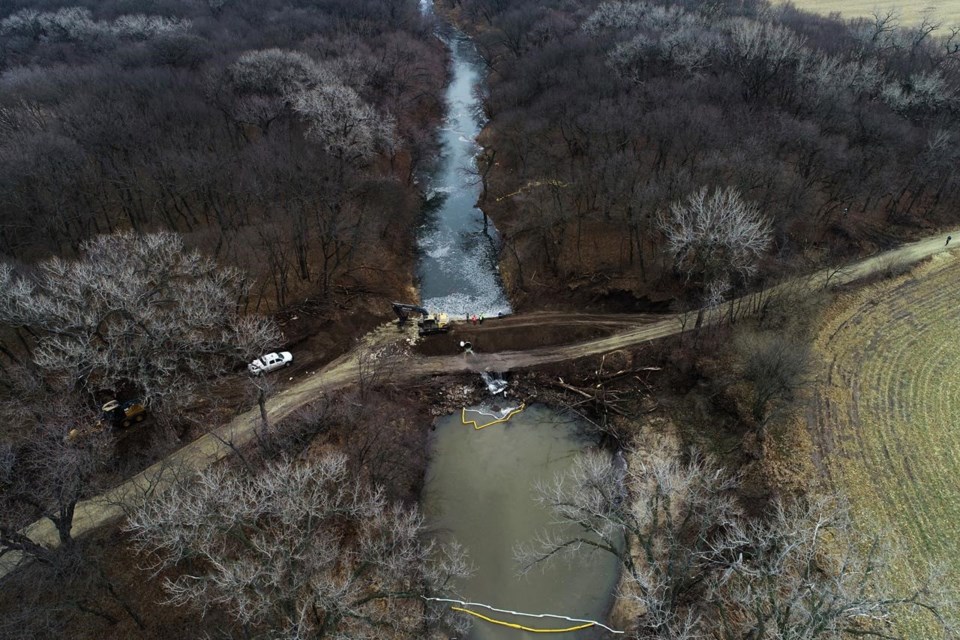CALGARY — TC Energy Corp. has received regulatory approval to restart the remaining segment of the Keystone pipeline that has been shut down since suffering its worst oil spill in the pipeline's history on Dec. 7.
The Calgary-based company said Friday the U.S. Pipeline and Hazardous Materials Safety Administration has approved a restart plan for the 154-km stretch of pipeline that runs from just south of Steele City, Nebraska to Cushing, Oklahoma.
The company said its restart plan will take several days and will include rigorous testing and inspections. It did not provide a date for when the entire pipeline system will be fully operational again.
Immediately following the spill, which saw 14,000 barrels of oil released into a creek in Washington County, Kan., TC Energy shut down the Keystone pipeline system, which stretches 4,324 km and helps transport Canadian and U.S. crude to markets around North America.
TC Energy restarted most of the pipeline, at a reduced pressure, on Dec. 14, although the section that runs from just south of Steele City, Nebraska to Cushing, Oklahoma remained shut down.
TC Energy and U.S. regulators are still investigating the cause of the spill, which eclipsed a 2017 6,600-barrel spill in North Dakota and a 2019 4,500-barrel spill in South Dakota as the worst oil spills in the Keystone pipeline's history.
The 2017 spill, in particular, was a blow to the Canadian oil industry. For the 10 days the pipeline was shut down, a lack of transportation capacity both to the U.S. storage hub in Cushing, Okla. and to refiners along the U.S. Gulf Coast caused a backlog of Canadian crude and forced producers to sell barrels at an increased discount.
That price depreciation didn't happen this time, however — in part because Canada now has more pipeline capacity than it did. (The addition of Enbridge's Line 3 replacement project came online in 2021, and Canada will have even more pipeline capacity next year after the TransMountain expansion project comes online.)
But Rory Johnston, a Toronto-based oil markets analyst and founder of the Commodity Context newsletter, said even with that additional capacity, any future pipeline outages that last for more than a few weeks could still cause significant problems.
"The Keystone outage reminds us of our vulnerability," Johnston said in a Dec. 21 interview.
"All of our pipelines (in Canada) are pretty large pipelines. We don't actually have that many pipelines. So if anything goes wrong with any one of those assets, we don't actually have a lot of resiliency in the system. And I think that's what Keystone has showed us."
Pipelines are widely considered by experts to be a safer mode of crude transport than either rail or truck. Still, the risk of a spill has long been a factor cited by environmentalists and others who have opposed North American pipeline construction projects in recent years.
For example, fears about potential pipeline leaks (as well as concerns about climate change) helped stoke opposition to TC Energy's proposed Keystone XL extension. That project would have cut across Montana, South Dakota and Nebraska but ultimately had its permit cancelled by U.S. President Joe Biden in 2021.
U.S. government data shows that the Keystone pipeline's safety record has been deteriorating in recent years.
A report released last year from the U.S. Government Accountability Office (GOA), a congressional watchdog agency, said Keystone's accident history has been similar to other crude oil pipelines since 2010, but the severity of spills has worsened in recent years.
The GOA report identified "construction issues'' leading to the material failure of pipe or welding material as a leading factor in past Keystone accidents.
It said the 2017 Keystone leak was caused by issues in the construction, installation, or fabrication of the pipeline, while the 2019 North Dakota accident was caused by defects in the original pipe manufacturing.
This report by The Canadian Press was first published Dec. 23, 2022.
Companies in this story: (TSX:TRP)
Amanda Stephenson, The Canadian Press




